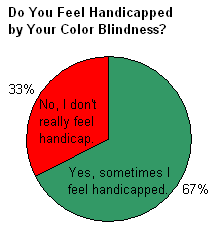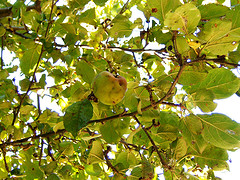I was trying to find out, if color blindness does handicap you in your everyday life or if you get along without this feeling. Thank you very much for participating in this poll which was started ten days ago with the question: Do You Feel Handicapped by Your Color Blindness?
| Answer | Votes |
|---|---|
| Yes, sometimes | 35 |
| No, not really | 17 |
| Not colorblind | 9 |
We had just over 60 people sharing their feelings about their color blindness with us. Nine of them aren’t colorblind themselves but still voted. This tells me that there are also a lot of people looking for information about color vision deficiency without suffering from it themselves. Thank you.
The other 52 votes can almost be split into two third/one third. Twice as many people feel handicapped as rather not. Of course this are very subjective impressions but that’s exactly what it is meant to be. Only if you are colorblind yourself you can judge about how it feels to carry this deficiency around with you every single day. And no academical study can ever prove it differently.

Looking at the numbers it is a very clear result we got here. To tell you the truth, when I started the poll I thought it would be maybe half/half between felling handicapped and not. But this results teach me that I was wrong.
There is also something else we have to take into account. Not everybody suffers the same severity of color blindness. And I suppose people with a less severe form would more likely vote for not feeling handicapped than people with some severe forms like dichromatism (red-, green- or blue-blind persons).
All together this tells you, that colorblind people definitely feel handicapped in their everyday life. There are so many situations and stories to tell where color blindness is a little or even a big burden.
And even so there is no organization or foundation, no real entry point for people looking for information about color blindness; and even more important, nobody represents the concerns of colorblind people towards the government, schools, employers…


